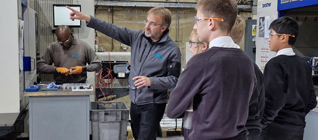SAND CASTING, GRAVITY OR HIGH PRESSURE DIE CASTING?
Once the most appropriate process has been selected, designers should decide upon the alloy which has the mechanical and physical properties most appropriate to the particular application, whilst also considering whether the casting characteristics are appropriate to the chosen process.
The table below will assist you to choose the process most appropriate to your requirements, however it is often necessary to obtain quotations for more than one process in order to decide which will be the most economic.
|
|
|
Sand Casting |
Gravity Die Casting |
|||
|
Tolerances on Critical Dimensions |
Up to 25mm Each Additional cm Across Parting Line Ad. |
± 1mm |
± 0.4mm |
± 0.1mm |
||
|
Minimum Taper |
On Inside Walls On Outside Walls |
2° |
1° |
1° 0.5° |
||
|
Minimum Wall Thickness |
On Small Castings On Large Castings |
3mm 5mm |
3mm 4mm |
1mm 2mm |
||
|
Minimum Size of Cored Hole |
15mm |
3mm |
2mm |
|||
|
Ability to use Sand Cores |
Yes |
Yes |
No |
|||
|
Surface Finish |
Poor 6.5-12.5 m |
Fair 4-10 m |
Good 1.5 m |
|||
|
Alloys commonly used in this form |
* * *
* *
* * * * |
* * *
* * *
* * * |
* *
*
* |
|||
|
Typical Production Quantities per annum |
1-500 |
250-50,000 |
2,000-500,000 |
|||
|
Typical Tool Life |
5,000 |
100,000 |
500,000 |
|||
Types of Casting
Gravity
Gravity Die Casting
Gravity die casting is produced by pouring molten metal into permanent cast-iron moulds. This process produces chill castings. The process has a higher casting rate than sand casting, but the metal moulds are higher cost than sand patterns. Advantages include the possibility of low gas porosity, and fine grain sizes can be obtained. Less finishing and polishing will be required than for sand castings. Gravity die casting tends to produce the highest quality castings, however the accuracy achievable is limited. Minimum wall thickness possible is c. 3-5mm.
Low Pressure
Low Pressure Die Casting
Low pressure casting is a development of the permanent mould process, in which the metal is introduced into the chill mould from below. Gas pressure holds the metal in the die until it solidifies. As with high pressure diecasting the process requires complex machinery. It is repetitive, and may be automated. Production rates are fair, but not as good as high pressure. Minimum wall thickness' are as little as 2-3mm. It has high yields of over 90%, as runners and risers are excluded, also reducing fettling and trimming costs. Pore-free castings are obtainable. Machine size will limit the size of castings. Surface finishing and minimum wall thickness' are both better than gravity die casting, but poorer than high pressure die casting.
High Pressure
High Pressure Die Casting
High pressure die casting, often shortened to Pressure Die Casting, is a repetitive process where identical parts are cast at high production rates by injecting molten metal under pressure into a metal die. Again, this process requires complex machinery. High pressure die casting is ideally suited to high production rates, and wall thickness' can be as little as 1-2.5mm. It provides the best surface finish (1.5m), and a very fine grain surface can be obtained. Pressure die casting has high strength. Castings may be quenched from the die. Machine size will limit casting size. Sound thick sections are difficult to cast, and core configurations must be complex to enable disassembly. High pressure die castings may suffer from porosity, although evacuated chamber and other techniques may reduce this. High start up costs are only reduced by long casting runs, thus enabling low unit cost with a high volume production. Pressure die castings cannot be fully heat treated.
Investment
Investment Casting
This casting method involves producing a "wax pattern" by injecting wax or plastic into a pattern die. The pattern is attached to gating and runner systems and this assembly is dipped in a hard setting refractory slurry which is then cured. The pattern is melted out of the mould to leave an exact cavity. The mould is heated to cure the refractory and to volatilize the remaining pattern material. The moulds are baked and molten metal is poured into the mould cavity. On solidification of the casting, the mould material is broken away from the casting.
Would you like to discuss your requirements?
contact us now
Notes for Designers of Non-Ferrous Castings
DOWNLOAD NOW Guides
HOW can MRT Castings help you?
I want...
- Select what you need
- a complete solution
- to develop a new component from initial concept
- advice on what processes are best suited to my component
- prototypes before committing to production tooling
- to re-shore production to the UK from overseas
- a new supplier to use existing tooling
- to convert a machined from solid part to a casting
- a supplier who can meet stringent quality requirements
New at MRT Blogs
We're pleased to share that MRT Castings will once again be exhibiting at Southern Manufacturing & Electronics
Read MoreOnce again, MRT Castings have partnered with Brother and their UK agent, Whitehouse Machine Tools – a relationship that has spanned more than 25 years.
Read MoreAt a time when young engineering talent is in short supply, MRT Castings is taking a proactive approach to recruitment.
Read More





